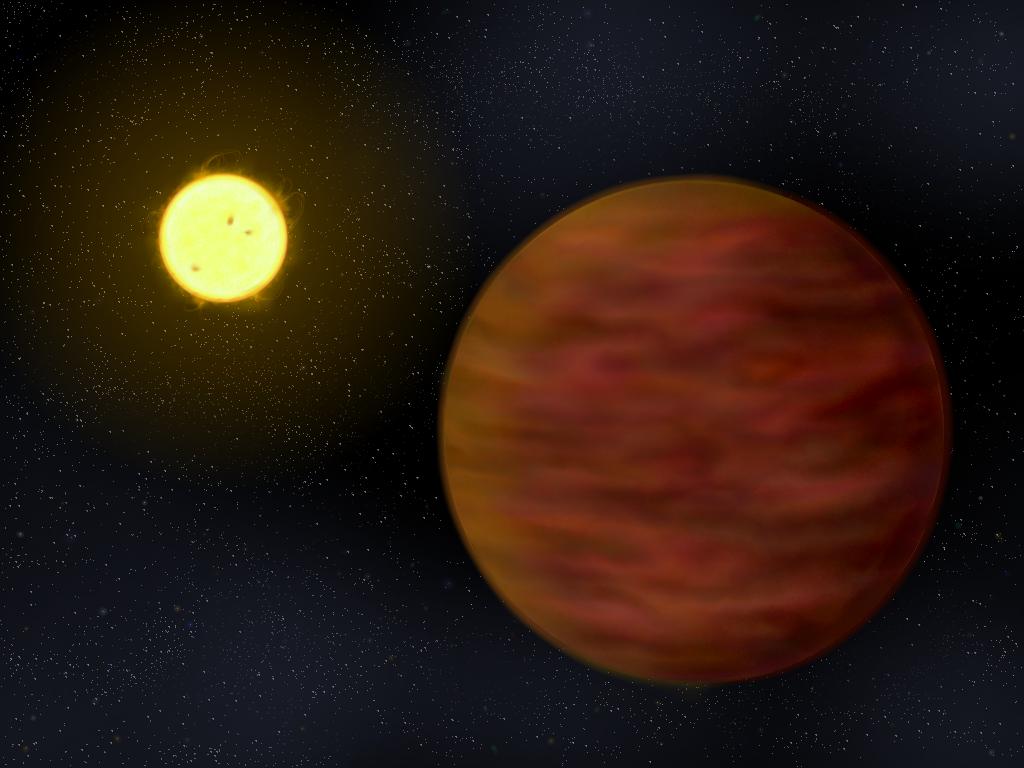Brown dwarfs, around the same size, are instead star-like objects with insufficient mass to ignite hydrogen fusion in their cores. Over time they cool to temperatures of just a few hundred degrees. Like stars, they formed from the collapse of a giant molecular cloud a few hundred light years across.
The difference between them, and their formation mechanisms, is not always an easy thing to determine but a brown dwarf known as known as BD+01 2920B is more than 99% hydrogen and helium and is ultra-cool like a giant planet, with a temperature of just 400 degrees Celsius. Its discovery could be a key step forward in helping astronomers distinguish between brown dwarfs and giant planets.

Graphical rendition of BD+01 2920B in the foreground (on the right hand side), with its host star in the background. The color and banded atmosphere of the brown dwarf result from atmospheric gases and turbulence. Credit: J. Pinfield, for the RoPACS network at the University of Hertfordshire
BD+01 2920B is in a binary system and about 35 times more massive than Jupiter. It orbits its host star at a distance of 390 billion kilometers or about 2,600 times the average distance from the Earth to the Sun. It was discovered using data from the Wide-field Infrared Explorer (WISE) satellite, the UK Infrared Telescope (UKIRT) in Hawaii and the Visible and Infrared Survey Telescope for Astronomy (VISTA) in Chile.
Searches for planets around other stars find many possible planets through the gravitational pull of the candidate objects on the stars they orbit as well as direct imaging using the latest optical technology on the largest telescopes - but compact brown dwarfs share many characteristics with giant planets, so astronomers struggle to confirm the nature of what they detect. The new work used data from ground- and space-based surveys and will be a template for easier distinctions, says David Pinfield of the University of Hertfordshire. "Surveys from telescopes like VISTA and UKIRT and orbiting observatories like WISE are giving us an unprecedented view of ‘ultra-cool’ bodies in our neighbourhood.
"By finding these rare objects in orbit around nearby stars, we get a handle on the bigger picture, that we live in a galaxy where both giant planets and brown dwarfs are commonplace."
Citation: Pinfield, D. J.; Burningham, B.; Lodieu, N.; Leggett, S. K.; Tinney, C. G.; van Spaandonk, L.; Marocco, F.; Smart, R.; Gomes, J.; Smith, L.; Lucas, P. W.; Day-Jones, A. C.; Murray, D. N.; Katsiyannis, A. C.; Catalan, S.; Cardoso, C.; Clarke, J. R. A.; Folkes, S.; Gálvez-Ortiz, M. C.; Homeier, D.; Jenkins, J. S.; Jones, H. R. A.; Zhang, Z. H., 'Discovery of the benchmark metal-poor T8 dwarf BD +01° 2920B', Monthly Notices of the Royal Astronomical Society, Volume 422, Issue 3, pp. 1922-1932. DOI:10.1111/j.1365-2966.2012.20549.x. Preprint: http://arxiv.org/abs/1201.3243






Comments